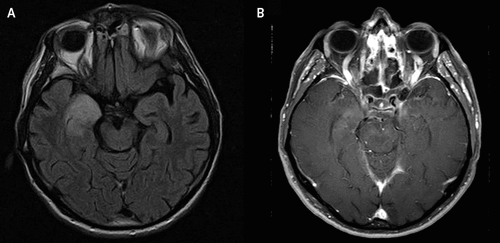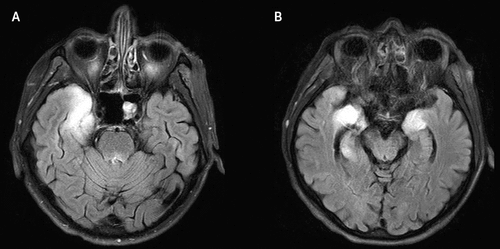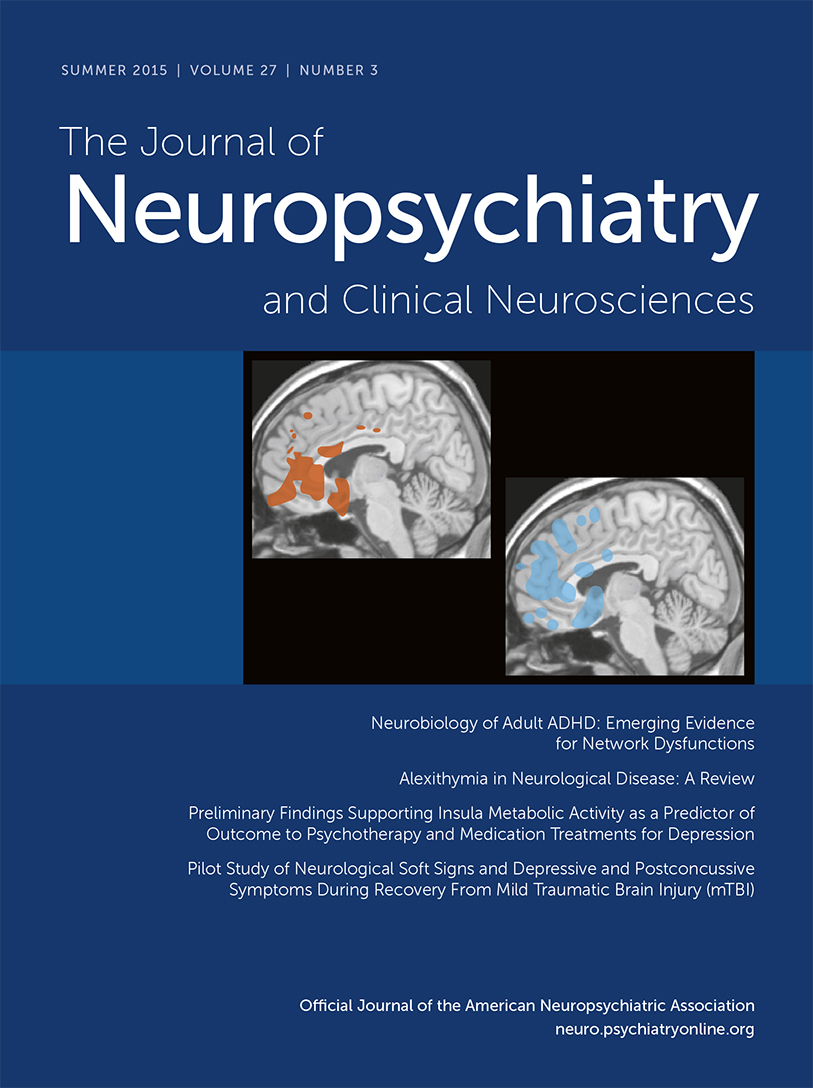Anti-Ma2 Antibody Encephalitis Manifesting as Cognitive Impairment and Psychosis
To the Editor: Anti-Ma2 antibody encephalitis is a rare autoimmune disease and is a paraneoplastic syndrome related with systemic cancers.1–4 The literature includes a few case reports in which anti-Ma2 antibody encephalitis involved the brainstem and limbic system; these patients showed neuropsychiatric manifestations, including neuro-ophthalmologic abnormalities, dizziness, headache, ataxia, seizure, and drowsiness.1–4 Given the rarity of the condition and the need to test levels of specific antibodies, diagnosing anti-Ma2 antibody encephalitis is a very difficult and challenging process. Therefore, a physician’s knowledge of and experience with autoimmune encephalitis are important for proper diagnosis and treatment. This report describes a patient with anti-Ma2 antibody encephalitis and a hidden malignant neoplasm who initially manifested acute cognitive impairment and psychosis.
Case Report
A 64-year-old man was seen at our hospital with a 2-month history of memory impairment, decreased speech, depressed mood, anxiety, disorganized language, aggressiveness, and excessive sleepiness. Results on neurologic examination revealed lethargy and cognitive impairment, but there was no evidence of cranial nerve abnormalities, motor weakness, or pathological reflexes. A brain MRI scan showed an infiltrative mass lesion in the right medial temporal lobe, suggestive of a brain tumor (Figure 1). Before surgery to remove the mass, the patient’s neuropsychological symptoms rapidly progressed and he exhibited decreased mentality, agitation, and aggressiveness. A follow-up brain MRI scan revealed further aggravation of the right medial temporal lobe lesion and new lesions involving the left temporal lobe (Figure 2). Because these findings were inconsistent with a diagnosis of brain tumor, evaluations for herpes simplex viral encephalitis and limbic encephalitis were performed. A CSF analysis showed elevated levels of WBCs (13/mm3) and protein (78 mg/dL). We performed a CT scan of the chest, neck, abdomen, and pelvis to exclude the possibility of hidden malignant neoplasms. A chest CT scan and [18F]-fluorodeoxyglucose positron emission tomography showed an ovoid nodule in the right apex with multiple lymph nodes in the hilum and mediastinum, indicating lung cancer (Figure 3). We also measured serum levels of anti-Hu, anti-Yo, anti-CV2/CRMP5, anti-Ri, anti-Ma2, and anti-amphiphysin antibodies associated with well-known paraneoplastic limbic encephalitis, as well as antibodies targeting neuronal cell surface antigens, ion channels (voltage-gated potassium channels), and ligand-gated ion channels (N-methyl-d-aspartic acid, AMPA, and GABA-B receptor channels). Only anti-Ma2 antibodies were detected. On the basis of these findings, the patient was diagnosed with anti-Ma2 antibody encephalitis and lung cancer, and he underwent a right upper lung lobectomy.

FIGURE 1. Brain MRI Scan Using (A) Fluid-Attenuated Inversion Recovery and (B) Gadolinium-Enhanced T1-Weighted Imaging Revealing a High-Signal Mass Lesion With Mild Enhancement in the Right Medial Temporal Lobe

FIGURE 2. Follow-Up Brain MRI Scan Using Fluid-Attenuated Inversion Recovery Revealing a Much-Aggravated Lesion in the Right Medial Temporal Lobe and Newly Developed Lesions Involving the Left Temporal Lobesa
a These findings were inconsistent with a diagnosis of brain tumor.

FIGURE 3. (A) Chest CT Scan and (B) [18F]Fluorodeoxyglucose Positron Emission Tomography Scan Showing an Ovoid Nodule in the Right Apex With Multiple Lymph Nodes at Both the Hilum and Mediastinum, Indicating Lung Cancer (White Arrow)
Discussion
Paraneoplastic limbic encephalitis is an autoimmune-mediated disease involving damage to the limbic system owing to antibodies generated in response to a remote malignant neoplasm.5–7 Anti-Ma2 antibody encephalitis is very rare and is characterized by neuro-ophthalmologic abnormalities, ataxia, seizure, dysarthria, and decreased mentality.1–4 However, unlike previous reports, our patient showed dominant psychiatric symptoms of memory impairment, decreased speech, depressed mood, anxiety, disorganized language, and aggressiveness, but there was no clear evidence of seizure, ataxia, neuro-ophthalmologic abnormalities, or systemic tumor. Therefore, although the patient manifested unusual symptoms, he did not visit the hospital for 2 months because his family assumed that he was experiencing psychiatric problems (e.g., depression, stress, and anxiety). His inflammatory brain lesion might have slowly progressed; his early psychiatric symptoms were consistent with the initial MRI finding of damage to the right medial temporal lobe and hippocampus. As his encephalopathy advanced, he experienced drowsiness and cognitive impairment. A second MRI scan revealed abnormalities in the limbic system, including the insular and temporal cortices and thalamus. When imaging findings and neuropsychiatric symptoms are anatomically unmatched, subsequent MRI scan and further evaluations are warranted to investigate the possibility of autoimmune encephalitis.
There have been reports of psychiatric manifestations of anti-Ma2 antibody encephalitis; however, this is a rare disease that is likely to be misdiagnosed as psychosis, brain tumor, or infection. This unusual case course serves to remind clinicians that patients who experience a first episode of rapidly progressing cognitive impairment and psychosis of an uncertain origin should undergo brain MRI scan, and the possibility of anti-Ma2 antibody encephalitis and hidden malignant neoplasms should be considered.
1 : Clinical analysis of anti-Ma2-associated encephalitis. Brain 2004; 127:1831–1844Crossref, Medline, Google Scholar
2 : Upbeat nystagmus in anti-Ma2 encephalitis. Pract Neurol 2014; 14:36–38Crossref, Medline, Google Scholar
3 : Microscopic dysgerminoma associated with anti-Ma2 paraneoplastic encephalitis in a patient with gonadal dysgenesis. Int J Gynecol Pathol 2013; 32:277–282Crossref, Medline, Google Scholar
4 : Anti-Ma2 antibody related paraneoplastic limbic/brain stem encephalitis associated with breast cancer expressing Ma1, Ma2, and Ma3 mRNAs. J Neurol Neurosurg Psychiatry 2003; 74:1332–1335Crossref, Medline, Google Scholar
5 : Paraneoplastic syndromes involving the nervous system. N Engl J Med 2003; 349:1543–1554Crossref, Medline, Google Scholar
6 : Neuro-ophthalmologic manifestations of a paraneoplastic syndrome and testicular carcinoma. Neurology 1999; 52:864–867Crossref, Medline, Google Scholar
7 : Recommended diagnostic criteria for paraneoplastic neurological syndromes. J Neurol Neurosurg Psychiatry 2004; 75:1135–1140Crossref, Medline, Google Scholar



